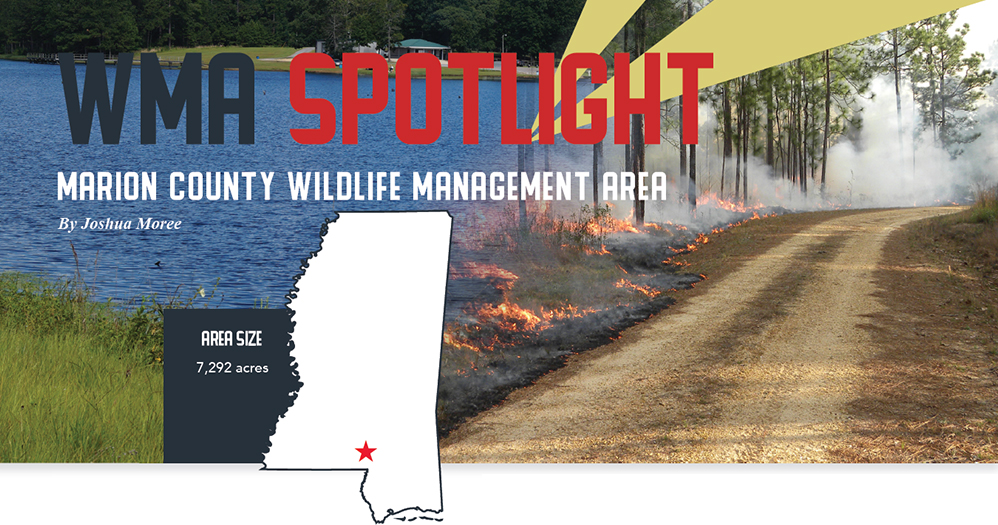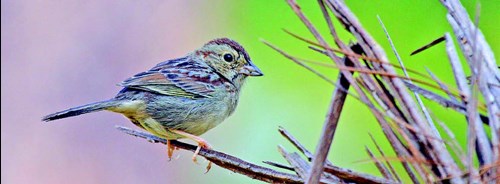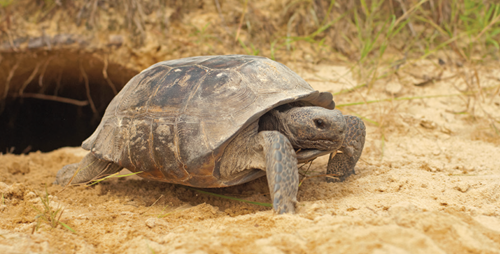WMA Spotlight: Marion County Wildlife Management Area
4/7/2020 9:17:11 AM
By Joshua Moree, Southwest Region WMA biologist for MDWFP.

Location
Marion County Wildlife Management Area (WMA) is located approximately 11 miles southeast of Columbia. From the intersection of highways 98 and 13, travel south on 13 for about eight miles. Turn left onto Game Reserve Road and travel approximately three miles to the WMA headquarters located on the right.
History
Marion County WMA is owned by Mississippi Department of Wildlife, Fisheries, and Parks (MDWFP) and consists of approximately 7,300 acres. The property was acquired from 10 private parties in 1949. It was one of the first two public land acquisitions conducted by the state. At the time of purchase, almost all timber had been harvested off the WMA. Old aerial images show the only remaining timber stood along creeks or other inaccessible areas. There were few improved roads on the WMA at the time. Most access was gained via old logging trails.
MDWFP (known then as Mississippi Game and Fish Commission) saw the importance of restoring this area to its native longleaf pine ecosystem. Roads were established for management and public access. Net-wire fencing was installed along the boundaries to keep free-ranging livestock from grazing on the WMA. Fire lanes were created for prescribed burns and protection from wildfire.
Later, in the 1960s and ’70s, Columbia and Bill Waller lakes were constructed within the WMA. Today, both lakes are managed by the MDWFP Fisheries Bureau.
As the longleaf forest began to return, so did huntable populations of deer, turkey, and small game. Restricted hunting regulations allowed these popular game species to recover and prosper, and Marion County WMA became a popular hunting attraction. Mississippi State University conducted white-tailed deer research projects on the WMA in the 1980s. Numerous studies of threatened species, such as the gopher tortoise and black pine snake, have been done on the WMA over the years.
Wildlife habitat
Marion County WMA lies within the Lower Coastal Plain soil region and is primarily forested with longleaf pine. Loblolly pine and mixed hardwood stands do occur within some areas of the WMA. Small streams and narrow bottoms occur throughout the WMA. These areas are generally mixed hardwoods, with gums, bays, maples, and oaks common.
Habitat management practices are focused on maintaining and improving the longleaf pine stands throughout the WMA. The primary management tool used is prescribed fire. Prescribed burning reduces competition from undesirable woody plant species, reduces the potential of wildfire, reduces the disease risk for young longleaf pine seedlings, and promotes the growth of desirable herbaceous vegetation favorable to many wildlife species.
Timber harvesting, primarily thinning, is another management tool used on Marion County WMA. Proper timber management is the greatest way to improve wildlife habitat on any forested landscape. Timber thinning opens the forest canopy, which allows sunlight to stimulate the growth of desirable forbs and grasses in the understory.
Recently, a 250-acre timber harvest was completed on the WMA. Portions of this stand had a heavy component of loblolly pine. The objective of this timber sale was to restore these areas to longleaf pine. The loblolly pine was removed throughout the stand. Most of the stand has adequate longleaf pine stocking and will be naturally regenerated. Areas, where longleaf pine stocking is too low, will be artificially regenerated with containerized longleaf pine seedlings.
Supplemental food plots and old field management are another part of the overall habitat management on Marion County WMA. Food plots are popular with deer hunters in the fall and winter, but they are not just for hunting. They can provide extra nutrition for deer during the late winter stress period when there may not be many natural food options available. Winter plots on the WMA are typically planted with winter wheat and clovers. Numerous old fields are maintained in early successional native vegetation throughout the WMA. These fields are managed by a combination of disking and prescribed burning. They provide fawning cover for white-tailed deer, as well as nesting and brood-rearing cover for wild turkeys and quail.
Wildlife and hunting opportunities
Visitors to Marion County WMA should be familiar with the current regulations. All visitors, unless exempt from purchasing an annual hunting or fishing license, must possess a valid WMA User Permit. Like other WMAs, most Marion County visitors come for hunting. However, hiking, horseback riding, and wildlife viewing are also popular.
For those interested in hunting small game, seasons follow very closely to statewide seasons. Special regulations apply to deer and turkey hunting. Deer hunters can enjoy either-sex harvest opportunities during portions of the season. However, weapon restrictions do apply, and season lengths differ from statewide seasons. Legal bucks on Marion County WMA are those with an inside spread of at least 12 inches or one main beam length of at least 15 inches. Deer hunting with dogs is not allowed. Turkey season on the WMA is shorter than the statewide season. Turkey hunting is open to youth hunters the last weekend of March and is open to everyone from April 1 through May 1.

Bachman's sparrow / Photo by Andy Wraithmell (CC BY NC ND 2.0)
Marion County WMA is also home to many significant non-game wildlife species, including the threatened gopher tortoise and black pine snake. The Bachman’s Sparrow, a species of management concern, also can be found on the WMA. Bachman’s Sparrows are rare as their populations have declined over 75% since 1970. Each of these species requires a fi re-maintained open pine woodland habitat for survival. Numerous species of butterflies are seasonally attracted to the native wildflowers found growing on the WMA.

Gopher tortoise / Photo by Jessica Brown
For more information on WMAs in Mississippi, visit www.mdwfp.com/wildlife-hunting/wma or contact MDWFP Wildlife Bureau at (601) 432-2199.
Joshua Moree is the Southwest Region WMA biologist for MDWFP.









